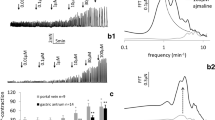Abstract
• Background and methods: In an attempt to clarify the functional action of histamine and substance P on atropine-resistant miosis, we isolated rabbit and human iris sphincter muscles and investigated their mechanical properties using the isometric tension recording method. • Results: Substance P dose-dependently contracted the rabbit iris sphincter, but had no effect on the human iris sphincter. In the rabbit iris sphincter, histamine reduced the amplitude of twitch contraction evoked by field stimulation but had no effect on carbachol-induced contraction. Thioperamide, but not mepyramine or cimetidine, partially antagonized the histamine-induced reduction in the amplitude of twitch contractions. In the human iris sphincter, on the other hand, histamine dose-dependently provoked contraction and the amplitude of histamine-induced contraction was affected neither by atropine nor by indomethacin. • Conclusions: These results provide evidence that histamine has strong contractile effect on the human iris sphincter muscle; the rabbit iris sphincter muscle, however, apparently lacks functional histamine receptors. In rabbits, exogenously applied histamine only activates H3 receptors located on the cholinergic nerve terminal, hence the excitatory neuro-effector transmission is suppressed. Thus, histamine may have an important roles in atropine-resistant miosis in humans, but not in rabbits.
Similar content being viewed by others
References
Alessandri M, Fusco B, Maggi A, Fanciulacci M (1991) In vivo pupillary constrictor effects of substance P in man. Life Sci 48:2301–2308
Bill A, Stjernschantz J, Mandahl A, Brodin E, Nilsson G (1979)Substance P: release on trigeminal nerve stimulation-effects in the eye. Acta Physiol Scand 106:371–373
Bito LZ, Baroody RA, Backerman A (1981) The mechanism of peptidergic miosis. I. The structural basis of miotic potency among biologically active polypeptides. Curr Eye Res 1:559–565
Camras CB, Miranda OC (1989) The putative role of prostaglandins in surgical miosis. Prog Clin Biol Res 312:197–210
Eakins K, Bhattacherjee P (1977) Histamine, prostaglandins and ocular inflammation. Exp Eye Res 24:299–305
Hill S (1990) Distribution, properties, and functional characteristics of three classes of histamine receptor. Pharmacol Rev 42:46–73
Ichinose M, Stretton C, Schwartz J, Barnes P (1989) Histamine H3-receptors inhibit cholinergic neurotransmission in guinea-pig airways. Br J Pharmacol 97:13–15
Keulen-de Vos H, van Rij G, de Lavalette J, Jansen J (1983) Effect of indomethacin in preventing surgically induced miosis. Br J Ophthalmol 67:94–96
Nowak JZ (1985) Histamine in retina, optic nerve, choroid and brain of albino and pigmented rabbits. Pol J Pharmacol Pharm 37:663–671
Nowak JZ, Nawrocki J (1987) Histamine in the human eye. Ophthalmic Res 19:72–75
Nowak JZ, Nawrocki J, Malinski C (1985) Histamine in the rabbit eye: distribution, synthesis, catabolism, and changes by light stimulation. Agents Actions 16:80–83
Stjernschantz J, Sears M and Stjernschantz L (1981) Intraocular effects of substance P in the rabbit. Invest Ophthalmol Vis Sci 20:53–60
Suzuki R, Kobayashi S (1983) Response of bovine intra-ocular muscles to transmural stimulation in the presence of various prostaglandins. Exp Eye Res 36:789–798
Ueda N, Muramatsu I, Sakakibara Y, Fujiwara M (1981) Noncholinergic, nonadrenergic contraction and substance P in rabbit iris sphincter muscle. Jpn J Pharmacol 31:1071–1079
Ueda N, Muramatsu I, Hayashi H, Fujiwara M (1983) Capsaicin and bradykinin-induced substance P-ergic responses in the iris sphincter muscles of the rabbit. J Pharmacol Exp Ther 230:469–473
Unger W, Tighe J (1984) The response of isolated iris sphincter muscle of various mammalian species to substance. P Exp Eye Res 39:677–684
Yoshitomi T, Ito Y (1988) Effect of indomethacin and prostaglandins on the dog iris sphincter and dilator muscles. Invest Ophthalmol Vis Sci 29:127–132
Yoshitomi T, Ito Y, Inomata H (1988) Functional innervation and contractile properties of the human iris sphincter muscle. Exp Eye Res 46:979–986
Author information
Authors and Affiliations
Rights and permissions
About this article
Cite this article
Yoshitomi, T., Ishikawa, H., Haruno, I. et al. Effect of histamine and substance P on the rabbit and human iris sphincter muscle. Graefe's Arch Clin Exp Ophthalmol 233, 181–185 (1995). https://doi.org/10.1007/BF00166612
Received:
Revised:
Accepted:
Issue Date:
DOI: https://doi.org/10.1007/BF00166612




